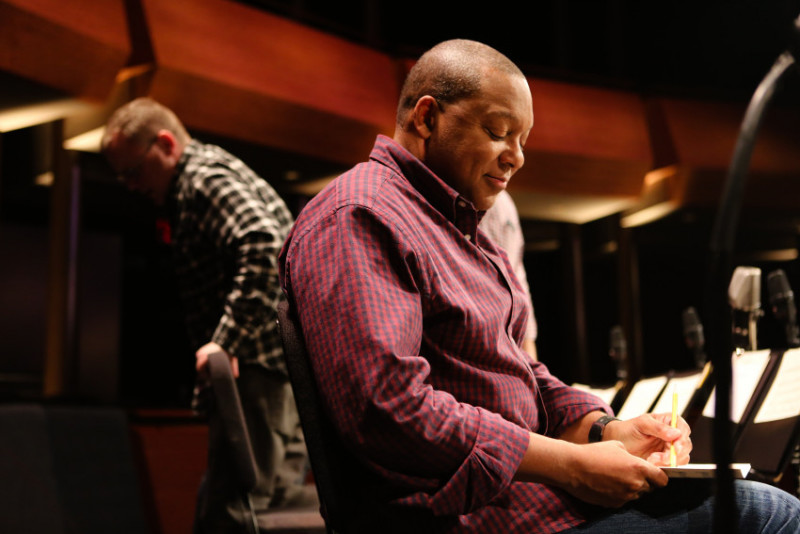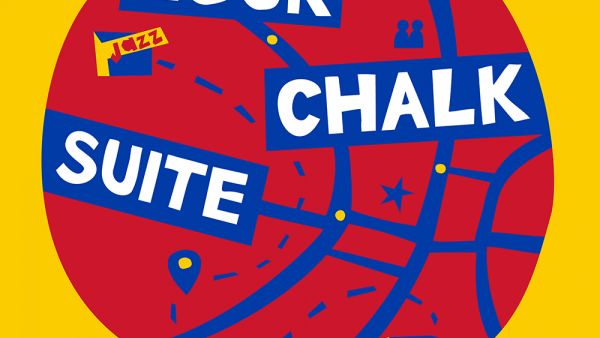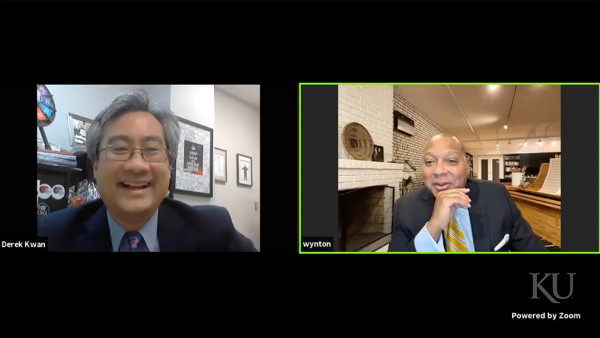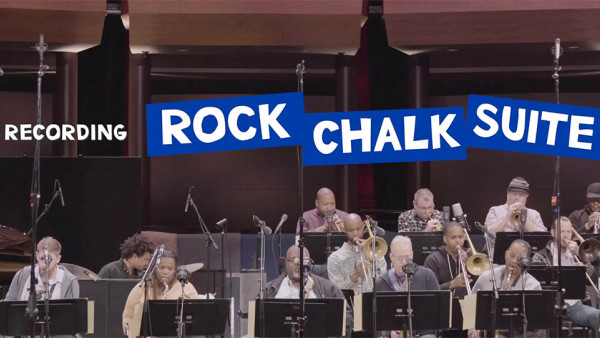The Stories Behind the Songs of the JLCO’s “Rock Chalk Suite”

Back in 2018, the Jazz at Lincoln Center Orchestra with Wynton Marsalis premiered the Rock Chalk Suite, a piece commissioned to celebrate the 25th anniversary of the Lied Center of Kansas. As the University of Kansas’s (KU’s) performing arts center, the Lied Center was eager to tell the storied history of Jayhawk basketball, and each of the JLCO’s members wrote a piece honoring a different KU hoops legend.
Below, you’ll find the JLCO’s musings on how they went about approaching their subjects and what it took to bring basketball from the hardwood and onto the bandstand.
Listen to Rock Chalk Suite now!
Wynton Marsalis on the Rock Chalk Suite:
The Rock Chalk Suite is a collection of musical portraits celebrating fifteen legends of the vaunted University of Kansas basketball tradition. Commissioned by Derek Kwan, executive director of the Lied Center, it is the first of its kind with twelve composers and arrangers from the Jazz at Lincoln Center Orchestra. A single work from many voices, this suite encompasses an unprecedented diversity of concepts, styles and approaches.
Jazz and basketball have an organic relationship on the most fundamental level. Both reward improvisation and split-second decision making against the pressure of time and the restriction of a clearly defined geometric form. And both have produced a roll call of greats whose individual styles and achievements expand and redefine our conception of the possible.
Our orchestra is privileged to service the sophistication and present-ness of jazz to honor this present moment of one of our country’s greatest sports legacies. Our suite features the chanting of the crowd, the squeaking of tennis shoes, the screeching of the referee’s whistle, the thump-thump of the bass drum, the wail of a siren saxophone, and the triumphant fanfare of trumpets.
We hope you enjoy it.
Chris Crenshaw on “The Y’s Guy” (James Naismith):
(Movement sponsor: David Booth)
Dr. James Naismith took a few international games, including one from his childhood called “Duck on the Rock,” and combined them into the game we would eventually know and love today called “Basket Ball.”
At the Springfield, Massachusetts YMCA, Naismith’s invention was the calm in the storm of restless children waiting to pass the time between winter and spring.
After a few experiments, he settled on 13 rules, allowed nine players a side, asked for a couple of peach baskets nailed ten feet high, and basketball was born. With this invention, he would become the founder and first coach of the Kansas Jayhawks basketball team.
For “The Y’s Guy,” I used the rhythm of the syllables to the word “basketball” for the melody. There are nine and 13-bar phrases in the A sections to acknowledge the sudden changes of possession in a then nine-on-nine game and the foundation of the 13 original rules. Instrumental unisons, duets and trios are used simultaneously to represent the visionary coach’s specifications for each player in accordance with the team’s talent and discipline.
Ted Nash on “Phog Allen” (Phog Allen):
(Movement sponsors: John & Rosy Elmore)
Dr. Forrest Allen earned his nickname “Phog” because his bellowing voice resembled a foghorn. He became known as the “father of basketball coaching,” and his legacy is forever etched into Kansas basketball history.
A student of the sport’s inventor, James Naismith, Dr. Allen first coached the Jayhawks in 1907! Largely through his efforts, the pastime was transformed into a professional sport. Many years later, in 1955, he persuaded a heavily recruited Philadelphia high school kid nicknamed “Wilt the Stilt” to come to the University of Kansas.
In 1927, Phog organized coaches to form a nationwide protest permanently postponing a change of rules that would have eliminated dribbling from the sport. This composition starts with a reference to dribbling, portrayed by the bass drum. After being interrupted by the ref’s whistle (played by the piccolos) we proceed with a modern, forward-thinking approach to honor Phog’s innovative methods and character.
Marcus Printup on “Jo Jo’s Mojo” (Jo Jo White):
(Movement sponsors: Scott & Linda Robinson and Chris & Jane Fevurly)
What is “Jo Jo’s Mojo?” Where do I begin? Jo Jo was always moving. Always hustling and giving 100% effort. Maybe this explains why he was drafted not only by the NBA, but also by MLB, NFL and the military!
The beginning of my composition represents his athletic prowess in all these endeavors. You may hear blocked shots, a swish, a home run, a touchdown, and maybe the firing of a wartime rifle. When these sounds all come to a halt, it represents Mr. White’s focus on basketball.
From here on out, it’s nothing but soul, grace, poise, fire and coolness, which defined his game and what I refer to as “Jo Jo’s Mojo.”
Wynton Marsalis on “The First Lady: Lyrical Lynette” (Lynette Woodard):
(Movement sponsors: In honor of Renate Mai-Dalton, Venkat & Neeli Bendapudi)
Lynette Woodard’s game is pure poetry, tensile strength and style. She is the number one leading scorer for this entire program: first in rebounds, in steals and in field goals made.
Ms. Woodard is the first lady to have her number retired in Allen Fieldhouse, she became the first lady to play professional basketball with men when she joined the Harlem Globetrotters, and she is first in the wave of ladies to inspire and populate the WNBA.
Lynette Woodard was always great: a two-time Kansas state champion in high school, four-time All-American at KU, and a member of more Hall of Fames than you knew existed. There is no question statistically; she is clearly the First Lady. But she is also first in grace, in elegance, in poise, and in the ability to negotiate difficult situations with ease and finesse. She is herself a song of complexity, depth and everlasting lyricism.
Victor Goines on “D(efense)-Up: The Untold Story of Darnell Valentine” (Darnell Valentine):
(Movement sponsors: Steve & Chris Edmonds)
Darnell Valentine’s stats rank him as KU’s all-time leader in free throws, seventh all-time in scoring, fifth all-time in assists, and the only player to ever be selected first team all-conference four consecutive times. As if that weren’t enough, he was also a three-time academic All-American, defining the term “Student Athlete.” Mr. Valentine was selected to the 1980 US Olympic basketball team and was the 16th overall pick by the Portland Trail Blazers in the 1981 NBA draft.
His offensive stats are superb, but, in the words of Coach Ted Owens, “…the thing that set him apart was his defense.” You know offense gets the headlines, but defense wins championships. Mr. Valentine’s all-time steals record of 336 still stands in testament to his greatness.
Just as defense was the centerpiece of Mr. Valentine’s game, the blues is the centerpiece of jazz. “D(efense)-Up” is a blues with constant references to the inspirational and much beloved fieldhouse chant of “Defense…Defense!!” and the coaches sideline prayer of “D-Up!”
As jazz musicians, we like to express ourselves over the 12-bar blues. However, in recognition of the exceptional character and talent of this Jayhawk legend, I have decided to make this piece correspond to his jersey number 14 and mirror the difficulty of playing good defense by composing an unbelievably fast 14-bar blues.
Dan Nimmer on “C.B.’s Theme” (Charlie B. Black):
(Movement sponsor: Cathy L. Daicoff)
Charlie B. Black was the first and only four-time first team All-American in Kansas basketball history.
To represent this four-time achievement, I utilized the most distinctive and crucial rhythm in jazz: 4/4 swing. The harmonic form represents his four-year career as a Jayhawk. The first two A sections, the main theme, symbolize his first two seasons.
The beginning of the bridge depicts his leave for a tour of duty in World War II. The end of the bridge is the climax of the piece. It represents his third and most successful season. The last A section is a restatement of the original theme, and it represents his senior season. As a tribute to Mr. Black’s jersey number 10, each last phrase of the main theme has 10 notes.
Paul Nedzela on “Third Quarter” (Nick Collison):
(Movement sponsor: Catherine Holland)
This composition captures what I feel I understand about Nick Collison as a human being. He was named Big 12 player of the year in 2002, and his Jayhawks went to the Final Four two times.
But before his NBA debut, Nick Collison had to have surgery on both shoulders and was forced to miss his entire first season. However, he persevered and went on to spend his entire NBA career with the Seattle Supersonics, who relocated in 2008 to become the Oklahoma City Thunder. Mr. Collison was such a stalwart and loyal foundation of the team that he became known as “Mr. Thunder.”
In this piece, I wanted to focus on Mr. Collison’s embrace of the game’s more unglamorous fundamentals and on the way he made the dirty work of taking a charge into a dance, represented in this song by the falls off the lower horns. In trying to capture that slow dance with his steadfastness, perseverance and unselfishness, this song in 3 is for #4, Nick Collison.
Sherman Irby on “The Truth” (Paul Pierce):
(Movement sponsor: Cathy Reinhardt)
This man was born as Paul,
He hails from Inglewood.
He mastered basketball,
on River City hardwood.
Paul played above the rim,
Yes, he could really fly.
But if you gave him space,
He’ll shoot a “3” in your eye.
And when he learned all he could from KU,
He set his sights on the NBA.
Pierce set his mark on the world in Beantown.
He was a mighty, mighty man at the Garden.
He got a ring and a MVP.
The best game closer around.
They hung his jerseys on high,
but he still mentors the youth.
You see, The Diesel was right,
That this man is “The Truth.
Elliot Mason on “Walt’s Waltz” (Walt Wesley):
(Movement sponsors: Roland & Joanne Hurst)
Walt Wesley is nicknamed “Wonderful Walt.” And I have to say after meeting him, I completely understand how he earned that name.
I grew up in England, so I think it’s fair to say… my basketball knowledge and University of Kansas history is extensively impaired.
However, after watching rare footage from Mr. Wesley’s professional career, I was inspired to compose to a single play from a 1970 Chicago Bulls & Golden State Warriors game.
Mr. Wesley’s movement mimicked an intricate dance that changed speed, direction and time in an instant. I represented this not only within the melody itself, but also by navigating through various Dance styles, including Tango, Waltz and Swing.
Kenny Rampton on “Passing Game” (Bill Hougland):
(Movement sponsors: Brad & Linda Sanders)
In 1952, Bill Hougland was the starting point guard for the championship Jayhawks. That year, he also won gold medals on the U.S. Olympic team. In 1952, jazz trumpeter Miles Davis released a song entitled “Dig,” which he wrote to the chord structure of another song, “Sweet Georgia Brown.” Ironically, “Sweet Georgia Brown” was adopted as the theme song for the Harlem Globetrotters, also in 1952.
In 1956, Mr. Hougland led the US to another gold, making him the first basketball player in US history to win two gold medals. In that same year, Mr. Davis re-released “Dig” as the title track of an album. I decided to incorporate the song structure of “Dig/Sweet Georgia Brown” into my composition.
Bill Hougland was a great team player and a true leader, known for giving everything he had at all times. I orchestrated my melody for him the same way that he orchestrated basketball plays for his team—by passing phrases throughout the orchestra. The first chorus features five musicians (two horns with piano, bass and drums) playing at a time. They are like the five basketball players on the court. Melodic phrases of differing lengths are passed from instrument to instrument in representation of the impressive ball movement of the 1952 team. Thus the title, “Passing Game.”
Wynton Marsalis on “I Cry Before My Country, I Leap Across Its Seas” (Wilt Chamberlain):
(Movement sponsor: Beverly Smith Billings)
Wilt Chamberlain was one of the greatest athletes of all time. A 7’1” center and track star with a whopping 48-inch vertical leap. His statistics in every category except free throws are far beyond the imaginable. He was the most famous college basketball recruit in 1955. Wilt was Philly, hip black youth culture and the east coast, coming out to the Midwestern farmland and integrating cultures at the dawn of the Civil Rights Movement. He was the promise of a national championship.
In Wilt’s sophomore season, KU lost the ‘57 championship by one point in a triple-overtime classic versus undefeated North Carolina. He felt he had let everyone down and was embarrassed and ashamed. Throughout his legendary professional career, Mr. Chamberlain remained a tough and solitary man who concluded, “Everybody pulls for David, nobody roots for Goliath.”
But when his KU jersey was retired in 1998, after four decades of estrangement, he came back, and we saw the unthinkable: tears of emotion from the Big Dipper. The love, appreciation and warm embrace of his Jayhawk family was instantly transformative. He spoke with vulnerability and honesty in one of the most moving moments in American sports and culture. Mr. Chamberlain recognized the supreme human value of a dedicated and supportive community. In putting the winning and losing of games in their proper context, he concluded, “I’m a Jayhawk, I know now why there’s so much tradition here and so many wonderful things have come from here, and I’m now very much a part of it and very proud of it. Rock Chalk Jayhawk.”
Vincent Gardner on “Miracles” (Danny Manning):
(Movement sponsors: Danny & Julie Manning)
“Miracles” is both dedicated to the great Danny Manning and is also a musical portrayal of the 1988 Jayhawks’ National Championship season. That team lost 11 times, including a late season defeat to the Oklahoma team they beat in the title game. It was all so improbable, the team earned the moniker “Danny and the Miracles.”
My composition converts many key numbers in the story of that season into musical devices. The melody “falls” in the beginning, depicting the way the Jayhawks’ season seemed to be tumbling down into mediocrity. The melody consists of phrases of one measure, nine measures, eight measures, and eight measures, signifying the year 1988.
There were five miracles on the court, so the musical interval of the fifth is used throughout. And finally, a little section of baritone saxophonist Gerry Mulligan-inspired “cool” style jazz depicts Danny Manning’s consistently level-headed approach in battling through the most pressurized situations during that unpredictable championship season.
Sherman Irby on “The Ponderous Pachyderm of the Planks” (Clyde Lovellette):
Movement sponsors: Jon and Vicki Jamison
In the mid-1940s, Clyde Lovellette was part of an emerging class of athletic and high-scoring big men in basketball. As a matter of fact, he led the nation in scoring his senior year and led the team to the NCAA Championship, becoming the first player to accomplish those feats in the same year. He was a terror on the court, both physically and verbally. He dominated the paint inside and was able to spread the floor with his outside shooting. In the NBA, Lovellette’s trash talk once riled up Wilt Chamberlain so much, The Dipper decked him right on the court (and didn’t even get ejected).
Love him or hate him, Mr. Lovellette was a true all-star, a member of the very elite group of greats to win both NCAA and NBA championships and an Olympic gold medal. Lovellette earned many nicknames over the years, but the craziest and most memorable is “The Ponderous Pachyderm of the Planks!”
Carlos Henriquez on “Wiggins in 6/8” (Andrew Wiggins):
(Movement sponsors: Jeff & Mary Weinberg)
Andrew Wiggins only played one season with the Jayhawks: 2013-2014. In 2014, he became the first overall pick in the NBA draft. He won Rookie of the Year honors for the 2014–2015 season with the Minnesota Timberwolves.
This piece features a melody of four notes that say the syllables of his name (An-drew Wig-gins). His fast pace up-and-down the court inspired a foundational rhythm of 4/4 swing at a fast tempo, and his height of 6 feet, 8 inches led me to utilize the African 6/8 groove as another rhythmic foundation.
Soloists play over a ten-bar harmonic form, which represents the five-on-five of offense and defense, and, finally, the mighty trumpets play on the half beat before beat one, which musicians count as “and one,” to signify the many fouls Mr. Wiggins would collect on successful drives to the basket (leading to the extra “and one” free throw shot).
Victor Goines on “The Shot” (Mario Chalmers):
(Movement sponsors: Miles & Paula Schnaer)
Originally from Anchorage, Alaska, Mario Chalmers must have been born with ice water in his veins. He made hitting the “clutch-shots” a part of his daily routine as a Jayhawk and in the NBA. While he is known for having great offensive and defensive statistics, and for making numerous buzzer beaters, Mr. Chalmers became a legendary Jayhawk for his final shot in regulation at the 2008 NCAA Final Four. “The Shot,” as it is known to most, tied the game between Kansas and Memphis, forcing an overtime, which was ultimately won by KU. Everyone who saw the game knew “The Shot” sealed the victory and Final Four MVP honors for Mr. Chalmers.
He went on to win two NBA Championships with the Miami Heat and to play with the Memphis Grizzlies.
This composition is simply entitled “The Shot.” It is based on the harmonies of the Jayhawk’s Fight Song #1. Rooted in the celebratory “Second Line” groove tradition of New Orleans, my piece honors Mario Chalmers for his outstanding career, accomplishments and contributions to this university.




